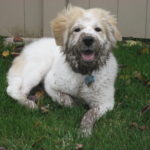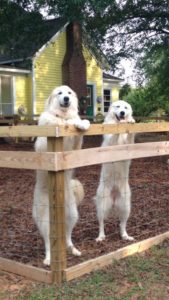There is a range of personalities among the dogs in any breed, Pyrs included, and while there is a general temperament associated with Pyrs, there are exceptions to the rule. I have seen a Pyr follow its owner around off leash without running off — once. Those dogs exist, but they are not the norm. Our Pyr, Leonidas, is. That’s why he ended up in rescue. His previous owner, who loved him, could not contain him in a too-short fence, and Leo was picked up by animal control many times for roaming until his owner was no longer able to retrieve him. If CGPR hadn’t taken him, Leonidas would have been put down. That’s a normal scenario explaining how many Pyrs end up in rescue. CGPR rehomes about 150 Pyrs each year. Many of the dogs come to rescue from shelters and were picked up as strays while roaming. Likewise, the owners who surrender dogs to us often do so because their Pyrs have repeatedly jumped short fences or went through underground or invisible fences. In some cases, these people shouldn’t have had a dog, but in most situations, these were good dog owners who didn’t have the means to care for a Pyr in their current living situation. It is not uncommon for a family living in a neighborhood with an HOA that prohibits fencing to have to rehome a dog that is roaming.
People who aren’t familiar with the breed’s history often misunderstand some key aspects of their protective nature. Pyrs are guardians. That does not mean that they are interchangeable with an alarm system or a lock on a door that will stay put in one place. Rather, a Pyr is hardwired to move around and roam in order to protect its territory and the things it considers its own within those boundaries. For this reason, the normal behavior expected of this breed is to want to take walk-abouts; they are designed to guard their flock by policing or patrolling. I have gotten used to seeing Leonidas walk the boundaries of our fence and pee along it each time we let him out. He’s doing his job no less than if he never left my side. It is unusual for Pyrs to want to always stay physically close to one human, although certainly some Pyrs do that. In addition to keeping Pyrs safe, fenced yards are essential to most Pyrs’ happiness in our modern communities. Many Pyrs will dig “Pyr pits,” lay in them, and supervise their world for hours. They love this, and the behavior is characteristic of the breed. To deny them this is to deny them joy and the ability to do their job for us. We have policies in place that respect the history of the breed and the purpose which it has so long served.
Fences that keep Pyrs in also keep out other animals and people. Pyrs get put down (or almost do, if it weren’t for rescues) for perceived aggression because they attacked something that came into their territory. In nearly all of these situations, the owners had failed to create a safe boundary around their Pyr with a fence. The same protective nature we admire in these dogs prompts some Pyrs to react when strange animals or people approach. It is unfair to blame a Pyr for biting in these situations, and yet this is what happens. Tie-outs and invisible fences only increase the likelihood of such incidents because they tend to aggravate Pyrs and don’t prevent others from coming near the dog.
For this reason, some animal control offers and kennel workers perceive Pyrs to be an aggressive (as opposed to a protective) breed. Those of us who regularly pull Pyrs from shelters for CGPR have interacted with staff who are shocked to see us fearlessly and lovingly greeting these dogs, including putting collars on them and loading them into our cars protected only by calm tones of voice and treats. I’ll never forget the first time I met a kennel worker who thought Pyrs were vicious. My love of the breed surprised her as much as her fear confused me.
 As a breed-specific rescue, it is our job to help educate others about the temperament of Pyrs. Occasionally, a Pyr is aggressive, and we volunteers always are watching for that when interacting with new dogs. In those cases, we make the sad call to humanely euthanize a dog that is a danger to humans. Thankfully, this is very rare. Sadly, a good Pyr who reacted with its mouth in a bad situation that wasn’t its fault is not, and we are lucky that many of the people who work in our state’s shelters recognize this about Pyrs and other guardian breeds. Otherwise, these dogs wouldn’t get second chances. Although not targeted nearly as often as other breeds, like pit bulls, Pyrs have been included in breed specific legislation, or “breed bans,” and some home insurance companies charge higher premiums to those who own breeds deemed “vicious.” It the duty of responsible Pyr owners to prevent the context for dog bites. Fencing is one of the best ways to do that.
As a breed-specific rescue, it is our job to help educate others about the temperament of Pyrs. Occasionally, a Pyr is aggressive, and we volunteers always are watching for that when interacting with new dogs. In those cases, we make the sad call to humanely euthanize a dog that is a danger to humans. Thankfully, this is very rare. Sadly, a good Pyr who reacted with its mouth in a bad situation that wasn’t its fault is not, and we are lucky that many of the people who work in our state’s shelters recognize this about Pyrs and other guardian breeds. Otherwise, these dogs wouldn’t get second chances. Although not targeted nearly as often as other breeds, like pit bulls, Pyrs have been included in breed specific legislation, or “breed bans,” and some home insurance companies charge higher premiums to those who own breeds deemed “vicious.” It the duty of responsible Pyr owners to prevent the context for dog bites. Fencing is one of the best ways to do that.
CGPR has been around since 1992 and has placed several thousand dogs since then. CGPR experiences a very low rate of returns, and that’s because the rules that we put in place generally work. While in rescue and foster homes, the president and volunteers interact with the dogs in order to learn who pushes boundaries, correct problem behaviors, and ensure that dogs are placed with humans who can care for them properly. We make the decisions we do because we love these dogs. Sometimes, they need a high fence and, preferably, a privacy fence that prevents the dog from even seeing the temptation on the other side or getting any traction if it does. We have never put down a dog for jumping, but we’ve waited to place many a dog until the right home became available. It is better than the alternative. It is heartbreaking for both loving dog owners and for the dogs when an adoption fails and the Pyr comes back to rescue. When a dog we didn’t suspect of being an escape artist is returned, we do our best to get it right the second time. To not do so would be cruel.
Every now and again, there might be a dog that Shannon, the current president, thinks does not need a fence. She’ll make that call. The vast majority of Pyrs who come into rescue do fit the normal temperament of the breed, however.
Unfortunately, that means we sometimes say “no” to really nice people. It isn’t personal. Some people try to argue. They say that they, a friend, or a neighbor had or has a Pyr that never roamed. We understand that those dogs exist, but they aren’t our norm. These folks also sometimes say their relationship with their Pyr will be different and that they will train their Pyr to never roam or jump. I smile. This is akin to expectant parents declaring their son or daughter will never test their boundaries, disobey, or leave home. I’m sure that child exists, but, as a professional educator, I have never met him or her!
I know these people don’t intend to be insulting, but what kind of relationships, pray tell, do they think we volunteers have with our Pyrs? One of the privileges of volunteering for a dog rescue is being able to bear witness to the loving, amazing, almost-can’t-find-words-for-it bonds that the Pyrs we’ve rescued have with the humans who’ve adopted them. A Pyr can sleep in a person’s bed, snuggle with them on the sofa, and obviously love them to the moon and back – and still want to take walk-abouts precisely because it is a Pyr.
That’s our Leonidas. In a dangerous situation, Leonidas would give his life to protect us, and Leonidas darted out of our yard twice before we reinforced those weak spots — because he wants to guard his neighborhood, the place we walk each day and that he marks. All of us who volunteer with rescue have stories about our dogs’ escapes. We search frantically until we find them, sometimes miles away. All of these dogs are loved by and love their owners. Many of these dogs have had years of training. Some are even therapy dogs. It doesn’t matter. First and foremost, they are Pyrs.
People who don’t know a lot about the breed will be impressed by a well-trained Pyr, but they don’t see the work that went into that dog (and still does) unless those of us who are responsible Pyr owners tell them. We emphasize to people who like Leonidas that our well-trained, mature Pyr, who is very bonded with us and often (not always) listens to our commands, is not what they’ll get from a young Pyr straight out of rescue. Dogs are work, and even after putting in a lot of it, we don’t fool ourselves that Leonidas wouldn’t still talk a walk-about in a heartbeat.
I hope this article clarifies why our fence policy is securely in place (pun intended). I know fences are expensive because we saved to put up ours, and yet I understand why we must say “no” to families without a fence, and why, like spaying/neutering, fences are not negotiable.
By Rose, Vice President, CGPR


 Those interested in adopting a Pyr should fill out the application on this web page. Please note, our software will not accept an incomplete application. If you hit send and do not receive a confirmation of receipt, please review the application and verify that you have filled in each required text box. If you still have a problem, email
Those interested in adopting a Pyr should fill out the application on this web page. Please note, our software will not accept an incomplete application. If you hit send and do not receive a confirmation of receipt, please review the application and verify that you have filled in each required text box. If you still have a problem, email 
 We place puppies at 13 weeks of age after full vaccinations. We keep our pups this long as a best practice facilitating proper socialization and the development of good manners. We appreciate that some people have strong feelings against spay/neuter before one year of age, and we are informed about the research for and against. Because we regularly see the negative health and socialization outcomes of the failure to spay/neuter and are committed to reducing the number of homeless and unwanted Pyrs in our region, we invite potential owners to have a conversation with us about benefits and risks. We welcome those who commit to spay/neuter at one year of age to complete a foster-to-adopt contract that becomes a finalized adoption when proof of spay/neuter is submitted.
We place puppies at 13 weeks of age after full vaccinations. We keep our pups this long as a best practice facilitating proper socialization and the development of good manners. We appreciate that some people have strong feelings against spay/neuter before one year of age, and we are informed about the research for and against. Because we regularly see the negative health and socialization outcomes of the failure to spay/neuter and are committed to reducing the number of homeless and unwanted Pyrs in our region, we invite potential owners to have a conversation with us about benefits and risks. We welcome those who commit to spay/neuter at one year of age to complete a foster-to-adopt contract that becomes a finalized adoption when proof of spay/neuter is submitted. CGPR adopts only to homes with a secure wood, vinyl, or metal fence that is at least four feet tall. Some dogs, particularly those we know to be jumpers and climbers, require taller fences and are rehomed only to those who can provide them.
CGPR adopts only to homes with a secure wood, vinyl, or metal fence that is at least four feet tall. Some dogs, particularly those we know to be jumpers and climbers, require taller fences and are rehomed only to those who can provide them.